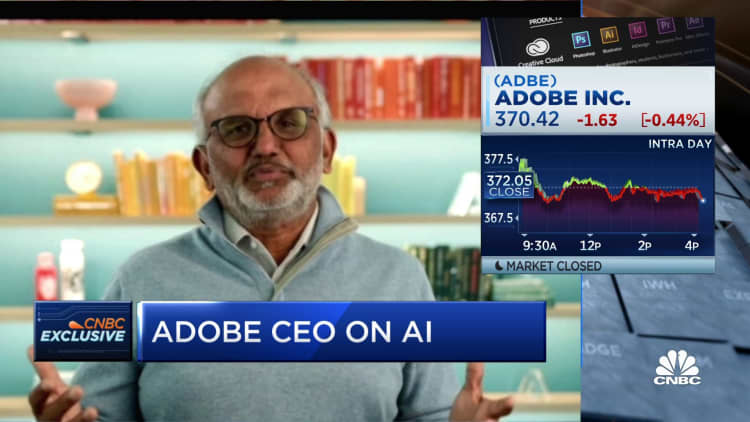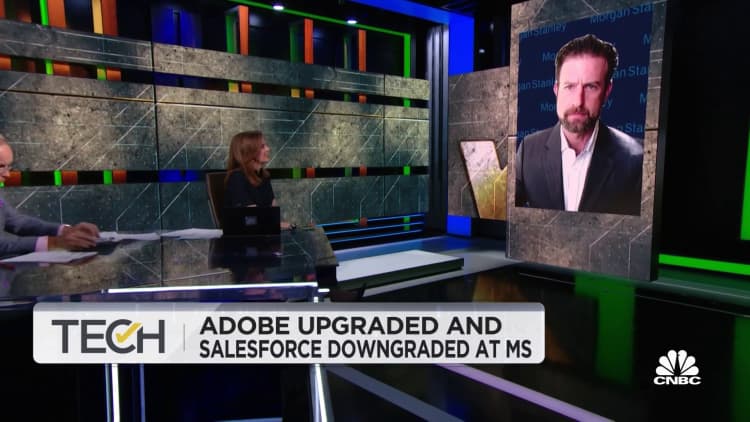
David Wadhwani, president of Adobe’s Digital Media unit, speaks at Adobe’s MAX conference in Los Angeles, October 2022.
Adobe
As generative artificial intelligence programs producing images, such as OpenAI’s DALL-E, Midjourney and Adobe‘s Firefly take off, graphic designers — many of whom operate as sole proprietorships — can’t ignore the usefulness of a tool that helps them to better meet the endless demand for visual content. But amid fears that AI will supplant creative professionals, they are exploiting a current limitation in the technology: the results are only as good as the human mind prompting the A.I. programs.
“The advances in AI affecting the world of graphic design are much of the same advances we’re seeing elsewhere,” said Nicola Hamilton, president of the Association of Registered Graphic Designers. “ChatGPT is becoming increasingly capable of doing our writing and planning, while Midjourney and DALL-E are creating pretty advanced artwork when given the right prompts,” she said.
For Hamilton, and many graphic designers, dealing with new technology is nothing new — it’s core to the evolution of their creative profession, dating back all the way to the democratization of printing, through the introduction of computers, the birth of the internet, and the prevalence of social media. “Graphic design is a fairly young profession. Originally we were tradespeople (printers, typesetters, sign painters) and our common understanding of design is tightly tied to both the popularization of advertising and the technological revolution,” Hamilton said.
How much time does generative AI save?
As designers experiment with gen AI, they are starting to answer a few big questions that surface amid any professional technology advance: How much time do the new tools really save designers? And can designers maintain the upper hand over the tech?
“The most promising (or terrifying) work in AI-generative artwork seems to be coming from Midjourney,” Hamilton said. She pointed to a project she saw presented at the Design Thinkers conference in Vancouver in June as an example of how to answer these questions.
Pum Lefebure, co-founder & chief creative officer at Washington, D.C.-based agency Design Army, created a campaign with the help of Midjourney for a high-end eyewear retailer Georgetown Optician — a fictitious planet of giant eyeballs. “It’s visually stunning, but as she revealed on stage, was a massive undertaking to create. Learning how to prompt the AI still requires an extensive knowledge of image making and a lot of hours,” Hamilton said.
Jake Lefebure, Pum’s husband, and co-founder and CEO of Design Army, said his firm sees AI as a tool, not a solution. “We use AI in a way that is more a creative tool process, as opposed to how a lot of people envision it: tell it what to do and all your problems can be solved.”
As an image board, or mood board, working alongside the designer across many iterations of a campaign, AI can play an important role, Lefebure said. But he added, “It takes a lot of finessing and you really need to train the AI. You need to craft the vocabulary to get the results you want. It’s not a mind reader.”
If how a designer articulates and phrases prompts dictates the results, that may become among the proprietary advantages at work in competition for campaigns. Lefebure did not want to discuss any best practices his firm has learned about generating successful image generation results.
Manipulating imagery is not a new practice for graphic design professionals. Stock photography, for example, has always played a role in the creative process.
“We use AI as a tool to create with, not something to just spit out into a design,” Lefebure said.
Adobe’s importance in the gen AI image era
While the names of the emergent generative AI starups such as OpenAI and Midjourney are first becoming known to many, these innovations are also beginning to be incorporated into the design products from one of the most successful companies in the S&P 500, Adobe. Hamilton said new AI applications are rolling out across Adobe products more slowly, but they are making big impressions.
Adobe Photoshop’s new AI Generative Fill, “is turning a lot of heads right now,” she said. “I don’t know how many designers know it by that name right now. I’ve been seeing each individual application of Firefly as a tool in its respective program — mostly applied through Photoshop. That being said, Adobe has a pretty tight grip on the industry. Once they move a feature out of beta, it’ll be industry standard in no time.”
Sole proprietor graphic designers competing with design firms may see the ubiquity of AI in such tools as time-savers and workload scalers. Hamilton says one of the most-repeated statements about AI is that “it’s just a tool.”
But she said there are multiple, specific examples of the way small to medium-sized design studios are making it a useful tool today. Among these examples: to build workback schedules (a reverse timeline calendar of tasks to meet project deadlines); to write rough drafts of client copy; and to build better mockups to present to clients. “Right now, the best thing designers can do is think of AI as a playground — it’s a place to experiment so that we can get to know the tool and begin to better understand the possible applications,” she said.

There are legal complexities to sort out. While some image firms have leaned into the generative AI space as a business opportunity, such as Shutterstock, Getty Images is among core creative asset vendors that taking legal action on copyright grounds.
One of the biggest concerns around AI and the design industry right now is copyright, and Hamilton noted that many of the generative image applications don’t own the artwork they are referencing. “Once that artwork has been generated, who owns it then? Can designers put it out into the world as their own? Can they sell it to a client to use as advertising? It’ll be years before we’ve regulated the ways AI-generated artwork is licensed, which is why it’s best to think about this space as a playground for now,” she said.
Adobe Photoshop will make it easy for students and young designers to generate AI campaigns, and the legal issues won’t be sorted out before those campaigns hit the market, but Lefebure said what’s more important is that these results won’t measure up to the level of competition from strong creative firms, where AI is part of the process, not the process. “If you want to be original, you need an idea behind that. True artists don’t use Adobe gen AI just to throw a cat into a design because you need a cat,” he said. “There has to be a reason and purpose behind how you use it.”
Demand for visual content has skyrocketed
At Adobe, executives are pushing the playground concept, and being careful in saying that AI image generation should be part of a larger creative process.
“The key use cases we see for generative AI in graphic design fall into inspiration — as a component into a mood board, for example; and composition — as an asset in a workflow to create an output for print or digital,” said Katie Gregorio, senior director of creative cloud marketing at Adobe. She pointed to past innovations as a guide. “As creators adopted new technologies, the creative processes adapted, new possibilities opened up, and more innovation occurred,” she said.
Sven Travis, associate professor of media and design at the Parsons School of Design, The New School, said while Firefly is one of many gen AI image tools, what distinguishes it is being integrated into the Adobe universe. Most graphic designers live within the Adobe ecosystem, so Firefly will be used, and will eventually eclipse most of the other tools, he said.
With Firefly, Gregorio said, work that used to take hours can be compressed into minutes. Creatives can generate images from a detailed text description with Text-to-Image; apply styles and textures to text fonts with a written prompt; use a brush to remove objects, or paint in new ones from text descriptions with Generative Fill in Photoshop; and generate color variations of vector-based graphics with everyday language using Generative Recolor in Adobe Illustrator.

Gregorio said that the majority of Adobe users, who range from solo freelancers to designers at the world’s biggest enterprises, say that they have adopted generative AI because it puts hours back into their lives at a moment when both the demand for content and the demands on their time have skyrocketed. “We are seeing this concern at every level: large enterprises and small businesses are faced with this content supply chain issue. They cannot deliver enough content fast enough, especially given the exploding demand for more personalized, custom-made content, and we see generative-AI tools as a big part of the solution,” she said.
For designers, this can all help in making a living, according to Travis. “AI can be hugely helpful in production and idea generation, and that saves time for small business operators,” he said.
That goes for idea generation through text as much as image generation, Travis said, with ChatGPT the best example. “You are a small designer, and have a client charge. Feed it into ChatGPT. Cycle through the output. You will very quickly come up with a variety of ideas for project execution — some you have already thought of, many you haven’t. Some will be viable, many won’t. But GPT accelerates this process tremendously,” he said. Then designers can take the ChatGPT results, and feed them into Firefly or Midjourney. “See what comes out. Revise the input. Repeat,” he added.
‘Hard to be authentic in artificial world’
Recent history shows digital tools can quickly become invisible and simply part of the way work is done. Designers who quickly become adept at getting the most out of the new tools can draw slightly ahead of the pack – for the time being – until the general capacity of the pack is up to speed. Generative AI may yet prove different, with a seemingly unlimited capacity for what it can do.
“It will likely make some designers redundant,” Hamilton said. “In the same way that Canva made some designers redundant, or the introduction of computers pushed some folks out of the industry. It’s all the more reason to dabble now, to get acquainted with the technology, and to look for ways we can make it work for us,” she added.
But the design experts say they will have to be proven wrong in the future about machine’s ability to supplant humanity’s creative edge. Many AI experts have said that in knowledge-based work, the bet they are making is that humans with AI replace humans without it, rather than machines replacing humans.
“The underlying notion of what it means to be a graphic designer hasn’t changed,” Travis said. “It is about creating effective visual communication. AI can’t tell us when we have achieved effective visual communications.”
Where designers have been left behind, he said, is when they refuse to embrace new technologies. “They were never replaced by those technologies,” Travis said.
As powerful as the tool is — and it already has proven it can create hyper-realistic output — “it’s the prompt,” Lefebure said. “AI won’t just make things because it’s bored. It might someday, but today, it takes a human to prompt an idea and that is uniquely distinct to that creator,” he said. “It’s hard to be authentic living in an artificial world.”
